

It is often very difficult to source examples of Stationery, ie Letterheads, Bills, Brochures etc, even from the recent past. Examples that I have found of the Company’s literature I have included here but there are gaping gaps and the chances of being able to fill them are not good. I have, whilst trawling through the documents at the Record Office left there by Henry Holladay, quite an interesting selection of the Rubber Stamps and Embossed stamps used by the business - anything without the “Ltd” is pre 1925 and cross reference with the Timeline will help the enthusiast in this field to more accurately ascertain the period of each differing style.
Generally samples of letterheads, even post World War 2, are hard to source. I have examples from the 40s and 50s but the latest I have found to date is April 1973.
A variety of printers were used, some no longer exist; names such as W.V. Cole & Sons, Wheatons, William Pollard, Besley & Dalgleish Ltd & the Devon & Somerset Steam Print Works of Exeter appear over the years. Pollards are very much still in business in Exeter but unfortunately they have not kept samples of the printing that they performed for Garton & King since 1945 and the destruction of their premises during WW 2 destroyed any that they might have had for pre 1940 years but they were, over the years, the preferred printer and indeed the Pollard and Holladay families were friends in my father’s and grandfather’s era; indeed the Pollard family were offered by my grandfather temporary accommodation in 3 Pennsylvania Crescent after their home was destroyed completely during the bombing of Exeter in WW2, which they eagerly accepted.
As is often the case nobody thought of keeping examples of printed matter during the latter years of the business and the thought did not occur to anyone involved in the clearing of the Offices, Machine Shop or Foundry at Tan Lane on the closure of the Foundry to do so. This was 1979 / 80.
HOWEVER! - anyone reading this article is encouraged, particularly if their work is for an established local business, to keep a watchful eye open. The Company installed heating systems in all manner of locations, many in Devon, and supplied castings for many local authorities as well as performing Aga Installations and selling Kitchen Appliances. Machine Work was performed at Tan Lane - and of course any member of staff would have received documentation from the Company in the form of Payslips and internal mail and even Forms of Apprenticeship and matters relating to their general employment and conditions. All these operations would have involved paperwork of some description, whether in the form of a quote, an advice note, a bill of sale, a Tender Document, or just a run of the mill letter.
Please contact me if you ever come across any of these items - see the About Me section.
Because of the omission of the word “Limited” (Ltd) all the Rubber stamps date prior to 1925 - the description of the operations of the business vary. One particular stamp of interest is the one showing the business as “King & Munk” and this can be dated to approximately 1883 / 1885.
The photo of the Embossed Stamp is from the 1924 / 1925 Document confirmimg the status change of the business to a Limited Company.
These are in rough date order - the earliest, 1788 is first. This is a small selection from the few examples that still exist. Much economy was exercised in the past and examples in the style of the Blue 1860s notepaper exist purely because they were torn in half and used as scrap or were written on or drawn on the reverse. Quite why blue was chosen as a colour for notepaper escapes me as the black printing does not stand out too well against this background colour.
Through my regular searching on a particular Auction Site I have recently (2018) come across a listing for a collection of material that I have acquired all relating to the same customer – as seen in the enlargements – they date between 1935 and 1941 and I have reproduced below seven examples, some may appear the same but are not. They actually cover an interesting period in the Company’s history and three are from the period when the country was at war. On this page is also an image of a Monthly Statement – not something one usually comes across, and an Account Rendered form. More information is shown below.
I recall that some headed notepaper was of particularly high quality with the words Garton & King in raised waxed lettering on a good quality paper. It may have been in use either just before but probably just after the Second World War. I am still looking for an example and it is now September 2018.
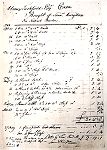 Very early paperwork from 1788 Goods bought from Samuel Kingdom. |
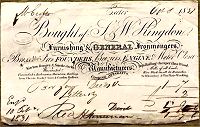 1831 Invoice issued by S W Kingdon. |
 Garton & Jarvis account from 1845 |
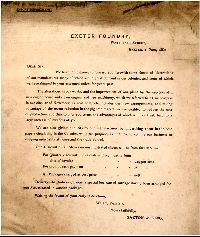 I recently discovered this Circular which has been hidden away in the Company Archives for over ten years. It contains some interesting information and in particular with regards to the new facilities and machinery now (1st June 1880) operational at the Waterbeer Street Foundry.
I recently discovered this Circular which has been hidden away in the Company Archives for over ten years. It contains some interesting information and in particular with regards to the new facilities and machinery now (1st June 1880) operational at the Waterbeer Street Foundry.
Click the image to enlarge.
I presume the advantageous terms offered with the ‘recent reduction in the pig iron market’ together with the benefit of the favourable Discount Terms offered on Stove Sales, resulted in increased buying from customers abroad as well as from the domestic market.
I have searched the archives but unfortunately there is neither sign of the letter sent in November (presumably 1879) nor the sheets of illustrations that this circular refers to.
 A bit of Historic background
A bit of Historic background
The formation of the General Post Office dates back to 1660 (a year older than Garton & King) under Charles II, though some say it was Oliver Cromwell. With the expansion of ‘Telegraphic Communication’ there followed authorisation by the Government to permit the General Post Office to offer services to the public. In 1912 the General Post Office took over the National Telephone Company and became the sole supplier of telephone services in the UK.
Garton and King took advantage of this ever increasingly popular method of communication, and referring to the illustrations above and records that exist we have some idea as to what numbers were allocated to the Company. The first number the Company was allocated was Exeter 104. This was in 1916 for sure but possibly earlier. |
By 1935 this had changed to Exeter 3904 |
The Telegraphic address in the 1920s was ‘Garton King’ Exeter. Using this short registered address saved having to use the complete postal address of the Company. By the late 1950s this was replaced by ‘Northams’ (the address of the former Taylor & Bodley premises in Commercial Road.) By 1981 this method of communication was obsolete and BT discontinued them on the 30th September 1982. (Telegrams - a quick & effective way to send a message by wire, popular in the era before telephones became commonplace).
There is no mention as to whether G & K were equipped with Telex but this method, introduced in the 1930s, was widely used until ultimately replaced by Fax in the 1980s.
For those whose interest is aroused by this sort of thing, the 54945 Telephone Number is a palindrome making it easy to remember. It continued as the ‘switchboard number’ up until 1973 when the Company was split into two operating divisions, Garton & King Ltd (Foundry & Engineering) who retained the 54945 number, and Garton King Appliances Ltd (Kitchen Appliances / Domestic Engineering) who were able to be contacted directly on 71829 at 19 North Street. When the Foundry closed, the 54945 number was retained by Garton King Appliances at their short-lived Richmond Road location, but eventually British Telecom upset the apple cart and added a ‘2’ to Exeter numbers sometime after the Holladay family relinquished interest in the business and that was the end of this easy-to-remember phone number.
Today’s Garton King Appliances’ customers should dial 01392 549539 for Darts Farm, or use the the still surviving 01392 254945 for their Offices at Unit 2 Fair Oak Court, Exeter.
A one time member of the office staff at Tan Lane in the mid 1970s commented that Henry Holladay was, to use her words “… also very careful not to waste paper, his handwriting was very small and he would start any letter on the back of a letter received that he no longer needed. However when he had filled up one side, he would then write on the front, across the top, in between the typing if it was double spaced, or down the side, round the bottom and back up the other side if need be - if he was running out of space he would write even smaller, which as he used a fountain pen sometimes did not make easy reading - as a final resort, he would start on a spare piece of paper, keeping tight to the top and then on finishing he would take his steel rule, place it close to his last line and remove the rest of the page. He’s the only person I've ever known who could fit 3 lines onto a sliver of paper no more than 1.5cms deep!”
One might query the truth behind this but the evidence is here. Trawling through ledgers the odd bits of paper have appeared. The writing may well be Mr Henry’s. The information written refers to the Foundry, AGA and Heating but there is no date and quite what the amounts refer to I cannot tell. What perhaps is more interesting is the reverse of these bits of paper. They are the front of two brown envelopes that had been torn in half. I have sellotaped them together and I have posted below the front and back. The larger of the two is dated the 2nd September 1938 and address to E. (Edgar) Holladay. The address is incorrect as it refers to Waterloo Street and not Waterbeer Street. (There was a Waterloo Road in Exeter at that time and still is, but no Waterloo Street.)
The second, smaller envelope is correct in that it refers to Waterbeer Street, however the new Exeter Foundry and Offices in Tan Lane were by then up and running as it is franked and postmarked the 16th September 1939, barely 13 days after we had declared war on Germany – it seems HEEH was not that frugal as he hadn’t steamed off the stamps!!
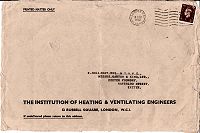 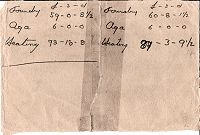 Envelope dated 2nd Sept 1938 |
  Envelope dated 16th Sept 1939 |
Updated February 2025
Top of page
See also:
King & Munk
144 Years of Newspaper Ads — Banking, Payment & Tokens
Waterbeer Street Foundry — Two Way Traffic — AGA
Sitemap / Contents